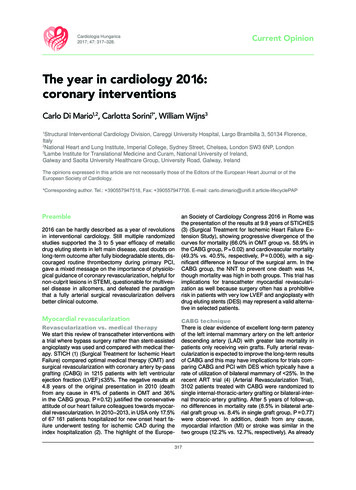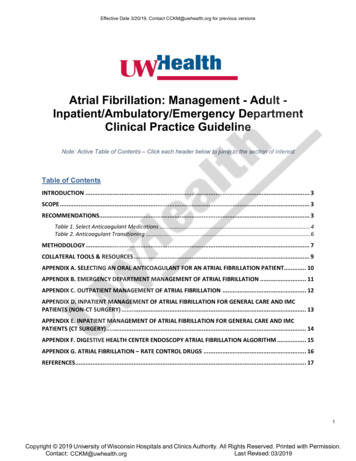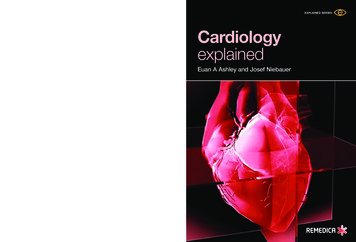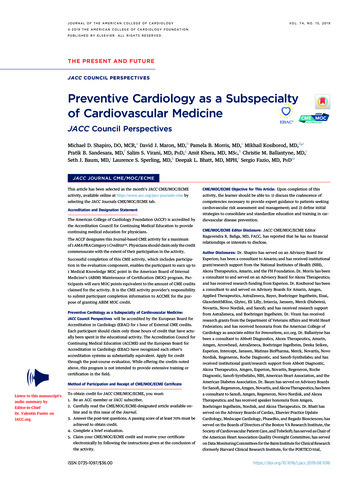
Transcription
Current OpinionCardiologia Hungarica2017; 47: 317–328.The year in cardiology 2016:coronary interventionsCarlo Di Mario1,2, Carlotta Sorini1*, William Wijns31Structural Interventional Cardiology Division, Careggi University Hospital, Largo Brambilla 3, 50134 Florence,Italy2National Heart and Lung Institute, Imperial College, Sydney Street, Chelsea, London SW3 6NP, London3Lambe Institute for Translational Medicine and Curam, National University of Ireland,Galway and Saolta University Healthcare Group, University Road, Galway, IrelandThe opinions expressed in this article are not necessarily those of the Editors of the European Heart Journal or of theEuropean Society of Cardiology.*Corresponding author. Tel.: 390557947518, Fax: 390557947706. E-mail: carlo.dimario@unifi.it article-lifecyclePAPPreamble2016 can be hardly described as a year of revolutionsin interventional cardiology. Still multiple randomizedstudies supported the 3 to 5 year efficacy of metallicdrug eluting stents in left main disease, cast doubts onlong-term outcome after fully biodegradable stents, discouraged routine thrombectomy during primary PCI,gave a mixed message on the importance of physiological guidance of coronary revascularization, helpful fornon-culprit lesions in STEMI, questionable for multivessel disease in allcomers, and defeated the paradigmthat a fully arterial surgical revascularization deliversbetter clinical outcome.Myocardial revascularizationRevascularization vs. medical therapyWe start this review of transcatheter interventions witha trial where bypass surgery rather than stent-assistedangioplasty was used and compared with medical therapy. STICH (1) (Surgical Treatment for Ischemic HeartFailure) compared optimal medical therapy (OMT) andsurgical revascularization with coronary artery by-passgrafting (CABG) in 1215 patients with left ventricularejection fraction (LVEF) 35%. The negative results at4.8 years of the original presentation in 2010 (deathfrom any cause in 41% of patients in OMT and 36%in the CABG group, P 0.12) justified the conservativeattitude of our heart failure colleagues towards myocardial revascularization. In 2010–2013, in USA only 17.5%of 67 161 patients hospitalized for new onset heart failure underwent testing for ischemic CAD during theindex hospitalization (2). The highlight of the Europe-an Society of Cardiology Congress 2016 in Rome wasthe presentation of the results at 9.8 years of STICHES(3) (Surgical Treatment for Ischemic Heart Failure Extension Study), showing progressive divergence of thecurves for mortality (66.0% in OMT group vs. 58.9% inthe CABG group, P 0.02) and cardiovascular mortality(49.3% vs. 40.5%, respectively, P 0.006), with a significant difference in favour of the surgical arm. In theCABG group, the NNT to prevent one death was 14,though mortality was high in both groups. This trial hasimplications for transcatheter myocardial revascularization as well because surgery often has a prohibitiverisk in patients with very low LVEF and angioplasty withdrug eluting stents (DES) may represent a valid alternative in selected patients.CABG techniqueThere is clear evidence of excellent long-term patencyof the left internal mammary artery on the left anteriordescending artery (LAD) with greater late mortality inpatients only receiving vein grafts. Fully arterial revascularization is expected to improve the long-term resultsof CABG and this may have implications for trials comparing CABG and PCI with DES which typically have arate of utilization of bilateral mammary of 25%. In therecent ART trial (4) (Arterial Revascularization Trial),3102 patients treated with CABG were randomized tosingle internal-thoracic-artery grafting or bilateral-internal thoracic-artery grafting. After 5 years of follow-up,no differences in mortality rate (8.5% in bilateral arterial graft group vs. 8.4% in single graft group, P 0.77)were observed. In addition, death from any cause,myocardial infarction (MI) or stroke was similar in thetwo groups (12.2% vs. 12.7%, respectively). As already317
Cardiologia HungaricaDi Mario et al.: The year in cardiology 2016: coronary interventionsFIGURE 1. EXCEL trial: primary composite end-point of death, stroke, or myocardial infarction at 3 years (on the left). FromNEJM, 2016. NOBLE trial: primary composite end-point of death, stroke, myocardial infarction and repeat coronary revascularization at 5 years (on the right). Reproduced with permission from Mäkikallio et al (7)shown in the 1 year follow-up report, wound infectionsand need for sternal reintervention were higher in thebilateral mammary group (P 0.005 and P 0.002).PCI vs. CABG in diabetesIn the choice between PCI and CABG appropriate patient selection appears the key factor. In 451 patientswith diabetes mellitus and renal failure (GFR 60 ml/min) presented in a subanalysis of the FREEDOM trial(5) (Future Revascularization Evaluation in Patients withDiabetes Mellitus: Optimal Management of MultivesselDisease), CABG was shown to be superior to percutaneous coronary intervention (PCI) in major adversecardiovascular and cerebral events (MACCE), particularly in terms of rates of spontaneous MI (HR 0.27, CI95%: 0.11–0.65) and repeat revascularization (HR 0.30,IC 95%: 0.18–0.50).PCI vs. CABG for left main diseaseTwo trials, EXCEL (6) (evaluation of XIENCE vs. Coronary Artery Bypass Surgery for Effectiveness of LeftMain Revascularization) and NOBLE (7) (NOrdic-Baltic-British LEft main revascularization), randomly compared PCI and CABG in 1905 and 1201 patients, respectively. The different results of the two trials are likelyexplained by differences in the stents used (the firstgeneration Cypher and Biomatrix in NOBLE and thesecond generation everolimus eluting XIENCE stentin EXCEL) and in the prespecified components of theprimary end-point (new revascularization in NOBLE,periprocedural large MI in EXCEL). At 3 years medianfollow-up EXCEL confirmed and improved the resultsof PCI in the left main (LM) subset of the SYNTAX trial,showing a clear non-inferiority of PCI vs. surgery in pa-tients with low to intermediate disease burden (SYNTAX score 33) and critical LM disease (incidence ofthe combined end-point of death from any cause, MIor stroke was 15.4% in the PCI group vs. 14.7% in theCABG group; P 0.02 for non-inferiority). PCI enthusiasts will claim that lower initial mortality, stroke andlarge MI and the absence of periprocedural surgicalcomplications (bleeding, infections, major arrhythmias,present in 3.7%, 2.5% and 2.1% of the CABG patients,respectively) are sufficient reasons to prefer PCI oversurgery. A more balanced view will stress the equalization of late results in the Kaplan–Meier curves for theMACCEs included in the primary end-point. The initialadvantage of PCI is lost at 3 years in EXCEL, when thetwo curves cross each other, and there is more frequent revascularization in the PCI group (12.6% vs. 7.5%in the CABG group, P 0.01). Still revascularization andstent thrombosis (0.7%) were much lower than in SYNTAX, while the incidence of symptomatic graft occlusion was similar in EXCEL and SYNTAX (5.4% and4.2%, respectively). NOBLE showed an unexpectedlylow incidence of stroke in the surgical arm, particularlyin the first weeks and an inferiority of PCI vs. CABGwhen revascularization is included in the primary endpoint (29% for PCI vs. 19% for CABG, P 0.006) (Figure1), with a statistically non-significant mortality difference in favour of surgery at 5 years (12% in PCI group vs.9% in CABG group, P 0.77).CTO treatmentVan der Schaaf et al. (8) were the first to demonstrate that patients with ST-elevation myocardial infarction (STEMI) and a second occluded artery had a muchworse prognosis, results later confirmed by many other318
Cardiologia HungaricaDi Mario et al.: The year in cardiology 2016: coronary interventions6.9%, P 0.001) (Figure 2). Registry data have obviousdrawbacks and the most important is that they do notconsider the entire population of the patients treatedbut only the 60–70% that typically achieve successfulprocedures. While waiting for the results of true randomized trials including in the CTO group all the patients with attempted recanalization (intention to treat),it is encouraging to see a progressive improvement ofsuccess rate (80–90%) in large consecutive registries.The RECHARGE (13) registry (REgistry of Crossbossand Hybrid procedures in FrAnce, NetheRlands, BelGium and UnitEd Kingdom) analysed 1177 patients withCTO (59% lesion length 20 mm, 58% calcific lesions,J-CTO score 2.2 1.3) and showed a high overall procedure success (86%) following a hybrid algorithm (anterograde wire escalation 77%, retrograde dissectionre-entry 17% and anterograde dissection re-entry 7%).Major in-hospital complications were low (2.6%) withvery low periprocedural mortality (0.2).FIGURE 2. Kaplan–Meier analysis of freedom from majoradverse cardiac and cerebrovascular events in patients withsuccessful PCI, failed PCI, patients managed with OMT orCABG, before propensity score adjustment. Reproducedwith permission from Tomasello et al (12)registries and subanalysis of randomized trials (HORIZONS) (9). The EXPLORE trial (10) (Evaluating Xience and Left Ventricular Function in Percutaneous Coronary Intervention on Occlusions After ST-SegmentElevation Myocardial Infarction), enrolled 304 STEMIpatients with coronary total occlusion (CTO) in a nonculprit vessel and randomized them to receive recanalization within 7 days from primary PCI or to culprit lesiontreatment alone. The primary end-point of LVEF andend-diastolic volume (EDV) at 4 months post-MI wasnegative (LVEF: 44.1 12.2% in the CTO PCI arm vs.44.8 11.9% in the conservative arm, P 0.60) with afavourable difference in favour of PCI only in patientsreceiving treatment of a CTO of the LAD.This result, the first reported of three randomized trials addressing the prognostic value of CTO treatment(the EuroCTO trial and a similar size Korean study haveboth completed enrolment last year), contradicts theoutcome of many large registries showing a favorable outcome of successful CTO recanalization. This wasconfirmed in the 14 441 patients included in the SCAARregistry (11) (Swedish Coronary Angiography and Angioplasty Registry) in the period 2005–2012. The presence of a CTO was an independent predictor of longterm mortality (HR 1.29, 95% CI: 1.22–1.37, P 0.01),with an average mortality increase of 6.6% each year.Successful CTO recanalization (54% of 6442 patientsunderwent PCI for CTO) was associated with a reducedmortality risk (HR 0.85, 95% CI: 0.73–0.98, P 0.034).In an Italian multicenter registry (12) (IRCTO), 776 patients (43.7%) were treated with PCI, showing lowermortality rate at 1 year than the patients on OMT or undergoing surgical revascularization (1.4% PCI vs. 4.7%and 6.3% surgery and medical therapy, respectively;both P 0.001) and lower MACCE (2.6% vs. 8.2% andBifurcationsThe guidelines (14) recommending provisional stentingas default strategy in bifurcational lesions were supported by results of 5 year survival of a patient level pooledanalysis of two randomized trials (15). In both studies,500 patients in the BBC-ONE trial (British BifurcationCoronary study One) and 413 patients in the NORDICtrial (Nordic Bifurcation study) were randomly assignedto provisional stent or a two-stent approach with the first generation drug eluting stents (DES) Cypher and Taxus. Five year mortality was lower among patients whounderwent a provisional strategy, 17 patients (3.8%) vs.31 patients (7.0%) in the two-stent strategy (P 0.04).When a second stent is required, the Bifurcation BadKrozingen (16) (BBK) randomized trial showed thatthe two most widely used techniques applicable ina provisional fashion (T-stenting and culotte) deliverdifferent results, with a significantly lower maximal instent % diameter stenosis at angiographic follow-up(P 0.038) and lower binary restenosis at 1 year follow-up in the 150 patients treated with culotte thanin the equal number of patients receiving T-stenting(6.5% vs. 17.0%, P 0.006). The clinical relevance ofthese findings is challenged by the absence of significant differences in TLR between the two groups (6%in culotte group vs. 12% in TAP group, P 0.069). Thistrial that utilized modern second generation DES hadexcellent overall results, and only one stent thrombosis at 1 year.Acute coronary syndromesThrombectomy for STEMIThe TOTAL trial (17) (ThrOmbecTomy with percutaneous coronary intervention vs. PCI ALone in patientswith ST-elevation myocardial infarction undergoing primary PCI) is a large multicenter trial where patients319
Cardiologia HungaricaDi Mario et al.: The year in cardiology 2016: coronary interventionsFIGURE 3. Primary and secondary end-points: (A) target lesion failure, (B) ischemia driven TLR, (C) target vessel MI, (D) stent orscaffold thrombosis in Absorb Japan trial. Reproduced with permission from Kimura et al (40)with STEMI were randomized to manual thrombectomyand PCI or PCI alone. The absence of any evidenceof improved prognosis at 30 days with the routine useof manual thrombectomy was confirmed at 1 year, witha small but worrisome increase in neurological eventsin patients receiving manual thrombectomy (1.2% vs.0.7%, P 0.015). In the angiographic sub-study of theTOTAL trial (18), routine thrombectomy did not impro-ve final MBG (myocardial blush grading) or TIMI flow(thrombolysis in myocardial infarction) when comparedwith PCI alone, but it was associated with a decreasedrate of distal embolization (7.1% in thrombectomy groupvs. 10.7% in PCI alone group, P 0.01), a complicationconfirmed as an independent predictor of mortality (HR3.00, 95% CI: 1.19–7.58). These two articles confirmedthe recent change in the US and European revascu-320
Cardiologia HungaricaDi Mario et al.: The year in cardiology 2016: coronary interventionslarization and STEMI guidelines that discouraged theroutine use of manual thrombectomy (14, 19) in primaryPCI.STEMI, immediate vs. deferred stentimplantationThe Danish registry DANAMI (DANish Study of OptimalAcute Treatment of Patients With ST-elevation Myocardial Infarction) analysed 3854 patients in the period2011–2014. In the DANAMI-3-DEFER (20), 1215 patients were randomized to receive standard primary PCIwith immediately stent implantation or deferred stentimplantation (median of 3 days) to reduce the risk ofembolization and no-reflow phenomenon. The primary end-point, a composite of all-cause mortality, hospital admission for heart failure, recurrent infarction, andunplanned TLR, was similar in the two groups (18% inimmediate PCI, 17% in deferred PCI, P 0.92). Distalembolization was observed in 10% and was equal inthe two groups (but crossover from deferred to immediate stent implantation was frequent, occurring in 22%of cases).Non-culprit lesion treatment in STEMIThe multicenter randomized DANAMI-3 PRIMULTI (21)trial addressed the recurrent question of the optimaltreatment of critical lesions in non-culprit vessels in 627patients undergoing primary PCI. FFR-guided complete revascularization during the initial hospitalization ofpatients with STEMI and multivessel disease improvedoutcome after 2 years of follow-up. Mortality and non-fatal MI were similar in the two groups but ischemia-driven repeat revascularization was 69% lower in the FFRguided group (17.0% vs. 5.0%, P 0.0001). This resultsuggests that a delayed in-hospital FFR guided revascularization should be preferred to a conservative symptoms guided strategy.Timing of PCI in NSTEMIThe European guidelines (22) recommend coronaryangiography and possible PCI within 24 h from hospital admission in patients with positive troponin orischemic ECG changes. In the RIDDLE-NSTEMI trial(23) (Immediate Versus Delayed Invasive Interventionfor Non-STEMI Patients), 323 patients with NSTEMIwere randomized to immediate intervention ( 2 h) anddelayed intervention (2–72 h). At 30 days, mortality andnew MI were lower in the immediate intervention group(4.3% vs. 13%, P 0.008), a difference that was confirmed at 1 year (6.8% vs. 18.8%, P 0.002).PCI in out-of-hospital cardiac arrest (OHCA)The optimal timing of coronary angiography is unclearin patients with OHCA and without ST-elevation. In thePROCAT II (24) registry (Parisian Region Out of hospital Cardiac ArresT), 695 patients after OHCA without STelevation and without extracardiac causes of the eventunderwent emergency coronary angiography (immediate transfer to cath lab like for primary angioplasty).In 403 patients (58%), at least one significant coronarylesion was observed and in 199 patients (29%), emergency PCI was performed. Successful recovery wasobserved in 43% of patients after emergency PCI and33% of patients treated conservatively, with successfulPCI emerging as an independent predictor of recovery(HR 1.8, 95% CI: 1.09–2.97, P 0.02).ACS in elderly patientsPatients older than 80 years with ACS are quickly increasing as a consequence of the aging world population but these patients are underrepresented in clinicaltrials and undertreated with invasive and pharmacological therapy. In the EIGHTY trial (25), 457 octuagenerians were randomized to invasive treatment or medicaltreatment. After 1.53 years of follow-up, the combinedprimary end-point of death, MI, urgent revascularization and stroke occurred in 40.6% of invasive group vs.61.4% of conservative group (P 0.001), with significant differences for MI and urgent revascularization. Nodifferences in bleeding complications were observed.Routine follow-up angiography after PCIThe REACT trial (26) (Randomized Evaluation of Routine Follow-up Coronary Angiography after Percutaneous Coronary Intervention) investigated the valueof routine coronary angiography 9–12 months after theinitial angioplasty, a practice widely used in all patientsin Japan and reserved outside Japan to selected subgroups such as LM or diffuse disease in diabetic patients.Unfortunately, the trial enrolled only 700 out of the 3300originally planned patients which precludes meaningfulsubgroup subanalysis. Results showed a 15% increasein revascularization as a consequence of the follow-upangiogram, not translating into a reduction of MI or mortality at 5 years follow-up. The result discourages routine use of diagnostic angiography but also shows thatover the first 5 years, the conservative group reachesthe same revascularization rate, a clinically mandatedcatch-up phenomenon that partially justifies the clinicalvalue of elective early retreatment.DevicesBare metal stent (BMS) vs. drug elutingstent (DES)The universal use of DES was challenged by the resultsof the NORSTENT trial (27) (Norwegian Coronary StentTrial), a randomized multicenter comparison of BMS vs.DES (82.9% everolimus-eluting stents and 13.1% zotarolimus-eluting stents) in 9013 Norwegian patients. Thestudy excluded, among others, patients with previouscoronary stenting or with bifurcation lesions requiringtreatment with a two-stent technique. Mortality andspontaneous MI, the primary end-point of the trial, were321
Cardiologia HungaricaDi Mario et al.: The year in cardiology 2016: coronary interventionssimilar in the two groups at 6 years (median follow-up59 months). The DES group showed a reduction in target lesion revascularization (TLR) (19.8% in BMS groupvs. 16.5% in DES group, P 0.001). The number needed to treat to prevent one repeat revascularization(NNT 30) was high in comparison to previous DESstudies but low when compared with the typical NNTof pharmacological studies. Concerns about high costcould have deterred doctors from using DES 5 yearsago when DES were much more expensive than BMS.This smaller than expected difference is unlikely to havean impact now, especially in the absence of any signalof possible increase of late in-stent thrombotic events(in fact there was a small but significant difference infavour of DES, definite or probable ST was 1.2% in theBMS group and 0.8% in the DES group, P 0.0498).For many years, BMS were preferred in patients at highrisk of bleeding to avoid the need of a prolonged double antiplatelet therapy or, worse, triple antiplatelet/antithrombotic therapy. Recently, this practice has beenchallenged by the availability of data showing safety ofearly withdrawal of dual antiplatelet therapy (DAPT) inpatients treated with second generation zotarolimus oreverolimus eluting stents. In the randomized multicenterLEADERS-FREE trial (28) better results were obtainedwith a polymer free biolimus A9 (umirolimus) DES usedwith only 1 month of DAPT in comparison with BMS.The significant reduction of TLR observed at 1 year(5.1% in DES group vs. 9.8% in BMS group, P 0.01)was confirmed at 2 years (29) (6.8% in DES group vs.12.0% in BMS group, P 0.001). In addition, a post hocanalysis of the LEADERS FREE trial confirmed theseresults in 1575 elderly patients (30) ( 75 years). Thecomposite safety end-point of cardiac death, MI and STwas reached in 14.3% of the BMS group and 10.7%of the DES group, (P 0.03). In addition, the primaryend-point of clinically driven TLR was worse in the BMSgroup (10.8%) than in the DES group (5.8%, P 0.01).The pre-specified subanalysis of the ZEUS trial (31)(Zotarolimus Eluting Endeavor Sprint Stent in Uncertain DES Candidates) showed that MACE were lowerin high risk bleeding patients treated with zotarolimuseluting stent than in BMS patients (22.6% in DES groupvs. 29.0% in BMS group, P 0.01). A prespecified posthoc analysis of the PRODIGY trial (32) (PROlongingDual antiplatelet treatment after Grading stent-inducedIntimal hyperplasia studY), analysed 323 patients withchronic renal failure (eGFR 60 ml/min/1.73 m2) withstable coronary disease or ACS undergoing PCI. It showed a lower risk of stent thrombosis and lower MACErate at 2 years in patients treated with everolimus orzotarolimus eluting stent than in patients treated withpaclitaxel eluting stents or BMS.Late follow-up after DESThe SIRTAX-very late trial (33) (Sirolimus-Eluting vs.Paclitaxel-Eluting Stents for Coronary Revasculariza-tion) reported 10 year results of a Swiss randomizedcomparison study between sirolimus eluting (CYPHER)and paclitaxel eluting stents (TAXUS). The fear wasthat a continuous progression of late lumen loss andthe development of accelerated neoatherosclerosis inDES could induce a poor long-term outcome. Resultsshowed that the annual risk of TLR between 5 and 10years was 60% lower than in the period between 1 and5 years (0.7%/year vs. 1.8%/year, P 0.001). Equally,the annual risk of very late stent thrombosis decreased during the extended follow-up period (5–10 years:0.23%/year vs. 1–5 years: 0.67%/year, P 0.01). In theISAR-Test 5 trial (34) (Intracoronary Stenting and Angiographic Results: Test Efficacy of Sirolimus and Probucol and Zotarolimus Eluting Stents), 3,002 patientswere randomly assigned to treatment with polymer-freesirolimus- and probucol-eluting stents (n 2002) orResolute stent (biostable polymer eluting zotarolimus,n 1000). The 5 year follow-up confirmed the non-inferiority of the first group for a composite of cardiac death,target-vessel related myocardial infarction, or TLR(23.8% vs. 24.2%, P 0.80). Stent thrombosis was lowand similar in the two groups (1.3% vs. 1.6%, P 0.64).In the EXAMINATION trial (35) (A Clinical Evaluationof Everolimus Eluting Coronary Stents in the Treatmentof Patients With ST-segment Elevation Myocardial Infarction), 1498 patients with STEMI treated with primaryPCI were randomly assigned to receive everolimus eluting stent or BMS. After 5 years, a composite end-pointof all-cause death, any myocardial infarction, or any revascularization was met in 21% of patients in the EESgroup vs. 26% in the BMS group (P 0.033), mainly driven by a lower rate of all-cause mortality (P 0.047).Comparison of modern second generationDESThe BIO-RESORT TWENTE III trial (36) compared twothird generation DES (sirolimus eluting Orsiro stent andeverolimus eluting Synergy) with biodegradable polymer coatings with a second generation durable polymerDES (zotarolimus eluting Resolute Integrity). Results in3514 allcomer patients showed very low incidence ofnew revascularization and very low stent thrombosis(0.3%), equivalent for the three platforms (P 0.7). ThePRISON IV trial (37) is a randomized, multicenter trialdesigned to evaluate the safety and efficacy of hybridsirolimus-eluting stents (SES) with bioresorbable polymer (Orsiro) compared with everolimus-eluting stents(EES) with durable polymers (Xience Prime) after CTOrecanalization. In 330 patients analysed in this trial, newgeneration DES did not meet the non-inferiority criteriafor in-segment late lumen loss when compared with second generation DES (0.13 0.63 mm in SES group vs.0.02 0.47 mm in EES, P for superiority 0.08). In addition, binary restenosis was significantly higher in SES(8.0% in SES vs. 2.1% in EES, P 0.028), while the clinical end-points were similar in both groups.322
Cardiologia HungaricaDi Mario et al.: The year in cardiology 2016: coronary interventionsBioresorbable ScaffoldsFour large multicenter randomized trials from Europe(ABSORB II (38), 501 patients), USA (ABSORB III (39),the largest with 2,008 patients), Japan and China (ABSORB Japan (40) and ABSORB China (41), 400 and480 patients respectively) compared a bioresorbableor a metallic stent eluting everolimus. ABSORB III showed non-inferiority of Absorb vs. Xience in terms oftarget lesion failure (TLF) at 1 year (7.8% for Absorbvs. 6.1% for Xience, P 0.16), cardiac death (0.6% vs.0.1%, P 0.29) and stent thrombosis at 1 year (1.5%vs. 0.7%, P 0.13). ABSORB China (41) focused on aprimary angiographic end-point of in-segment late lossand showed a low late lumen loss at 1 year (0.19 0.38mm) in the Absorb group, non-inferior to the 0.13 0.38mm observed in the Xience group. Angiographic restenosis at 13 months was low, 1.9% and 3.9% (P 0.31)in the Absorb Japan trial (40). In a large patient-levelpooled meta-analysis, 3389 patients (42) from four trials with stable coronary disease or ACS were randomized to receive BVS (2164 patients) or metallic EES(1225 patients). No significant differences were observed in the patient oriented composite end-point ofall cause mortality, all MI or all revascularization at 1year, and in the device oriented composite end-point ofTLF, including cardiac mortality, target vessel relatedMI or ischemia driven TLR (P 0.17). The most worrisome data came from the 3 year results of the oldestof these studies, ABSORB II (43). Unexpectedly, theprimary end-point of vasomotor reactivity did not differin the two groups (0.047 mm for BVS vs. 0.056 mmfor EES, Psuperiority 0.49). Six patients experienceddefinite very late scaffold thrombosis in the BVS group(2.0% in total vs. 0% in the XIENCE arm, P 0.19), witha higher incidence of clinically indicated TLR (6% vs.2%, P 0.04). While presenting these results, Serruyscalled for a prolongation of double antiplatelet therapyand suggested a drastic modifications of the protocolof stent implantation recommended in the ABSORBII study, with rare use of imaging and post-dilatation.More fundamental criticisms pointed to the limitationsof the current ABSORB platform (strut thickness of 150micron, low radial force, 0.5 mm margin for further diameter expansion, lack of X-ray visibility), enhancingthe interest for the favorable results of initial registriesof thinner biodegradable stents. These results are certainly upsetting those cardiologists who believed thatan initial greater complexity of implant and a possibleprice to pay in terms of higher early stent thrombosiswas due to be compensated by an absolute absenceof late events after the completion of the absorptionprocess. The follow-up duration might be insufficientfor a complete absorption of the PLLA when the strutsare detached from the wall and gross persistent abnormalities of vascular rheology due to malapposed strutscan trigger thrombosis even after complete absorptionif intraluminal strands remain.Other devicesSevere coronary calcification remains a predictor ofworse clinical outcomes. In the ORBIT II trial (44) (Evaluate the Safety and Efficacy of Orbital Atherectomy System in Treating Severely Calcified Coronary Lesions),443 patients with severe calcified lesions were treated with orbital atherectomy for pre-stent implantationpreparation. The 2 year follow-up of the ORBIT II trialextended the favorable results previously shown at 30day and 1 year follow-up: MACE was 19.4%, all-causedeath 7.5%, cardiac death 4.3%, and TLR 6.2%. Thestratification for stent type showed a worse result inBMS vs. first and second-generation DES (TLR15.1%in BMS vs. 6.3% first-generation DES vs. 5.0% in second-generation DES, P 0.047). The DISRUPT CADtrial is the first coronary experience with a lithoplastyballoon (Shockwave Medical) (45), a device previouslyused only in peripheral vessels. Sixty patients with moderate or severe calcific lesions (stenosis 50%, reference vessel diameter 2.5–4.0 mm, lesion length 32mm) were treated before stenting with excellent stentexpansion and OCT documented fractures of superficial calcifications in 58%. This device proved to be safe,with no final angiographic complication and a low 30day MACE (no death, no Q-wave MI, 5% non-Q MI).Both orbital atherectomy and, especially, the revolutionary approach of lithotripsy of coronary calcium havethe potential to greatly improve the effects limited to superficial calcium achieved with Rotablator but, so far,no comparison data are available.Functional and imaging guidanceFractional flow reserve (FFR) for intermediate lesionsDEFER (46) was the first study confirming the clinicalusefulness of FFR showing similar freedom from major adverse cardiac events (death, MI, and repeat revascularization), the primary end-point of the trial, withdrawing PCI in patients initially
317 Cardiologia Hungarica 2017; 47: 317-328. Current Opinion The year in cardiology 2016: coronary interventions Carlo Di Mario1,2, Carlotta Sorini1*, William Wijns3 1Structural Interventional Cardiology Division, Careggi University Hospital, Largo Brambilla 3, 50134 Florence, Italy 2National Heart and Lung Institute, Imperial College, Sydney Street, Chelsea, London SW3 6NP, London










